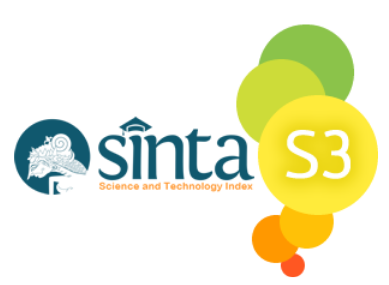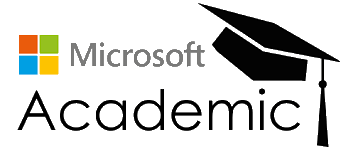STUDENT'S MULTIMODATED COMPETENCY IN DIGITAL LEARNING IN UNIVERSITIES
Abstract
Multimodal competence of students needs to be trained as the necessary skills for the needs of technology and communication in the digital era. Technology and information skills in question are competencies to obtain information and produce knowledge in the digital era. In learning in higher education, it is expected that students can find their identity and develop naturally with lecturers' facilitators in paying attention to concepts and their psychological development. The general purpose of this study is to explain the multimodal learning model of students in higher education. Specifically includes learning steps, role guidelines, evaluation instruments and learning impacts. This research uses a qualitative approach with a case study method. Qualitative research with the case study method was chosen to gain a thorough and in-depth understanding of the multimodal learning model of students in higher education. This approach is used to explain and explore the use of student multimodal learning models in universities. The research data are students' verbal and written speech related to learning steps, role guidelines, evaluation instruments and the impact of digital learning. The results showed that the use of a learning management system (digital) in learning psychology of multimodal literature in this study could improve students' multimodal competence. Increasing students' multimodal competence is shown by interaction during the learning process. With a learning model that includes learning steps, role guidelines, evaluation instruments and learning impacts emphasizing the use of LMS and various digital learning resources, it can improve students' multimodal competence by utilizing various modal modalities (language, music, sound, images, movement).
Keywords
Full Text:
PDFReferences
REFERENCES
A. Muri Yusuf. (2016). Metode Penelitian Kuantitatif, Kualitatif & Penelitian Gabungan. PT. Fajar Interpratama Mandiri. Yusuf, A. M. (2016). Metode Penelitian Kuantitatif, Kualitatif & Penelitian Gabungan. Prenada Media.
Belvage, R. H. (2012). Budaya manusia digital. 1, 22–28.
Camilleri, P. (2021). Robot-proof : higher education in the age of artificial intelligence Robot-proof : higher education in the age of artificial intelligence. Journal of Education for Teaching, 00(00), 1–2. https://doi.org/10.1080/02607476.2018.1500792
Cheng, Y., & Liu, W. (2014). A Multimodal Discourse Analysis of the Relationship between Pi and Richard the Tiger in the Movie Life of Pi. International Journal of Language and Literature, 2(4), 191–219. https://doi.org/10.15640/ijll.v2n4a11
Coccetta, F. (2018). Developing university students ’ multimodal communicative competence : Field research into multimodal text studies in English. System, 1–9. https://doi.org/10.1016/j.system.2018.01.004
Daryono, D. 2021. (2021). Society 5.0 Leading In The Borderless World (D. Karmiyati (ed.); 2021st ed.). CV. Bildung Nusantara, 2021.
Firmansyah, M Bayu, & Rokhmawan, T. (2018). Pengembangan Kompetensi Komunikasi Multimodal Mahasiswa STKIP PGRI Pasuruan. Jurnal Ilmiah Edukasi Dan Sosial, 9(September), 124–133. http://www.jiesjournal.com/index.php/jies/issue/view/9
Firmansyah, Mochamad Bayu. (2018). MODEL PEMBELAJARAN DISKUSI BERBASIS PERILAKU BERLITERASI UNTUK KETERAMPILAN BERBICARA_BAYU_sept_2017. Edukasi Dan Sosial, 8(September 2017), 119–125. https://doi.org/10.31227/osf.io/ebx9j
Firmansyah, Mochamad Bayu. (2021a). MULTIMODALITAS MODEL PEMBELAJARAN PSIKOLOGI SASTRA (T. D. P. Khatulistiwa (ed.); 2021st ed.). Delta Pijar Khatulistiwa. https://scholar.google.com/scholar?cluster=12823019664925397591&hl=en&oi=scholarr
Firmansyah, Mochamad Bayu. (2021b). The Effectiveness Of Multimodal Approaches In Learning. Journal of Education And Technology, 4(3), 469–479. https://www.researchgate.net/profile/Bayu-Firmansyah-2/publication/350613421_The_Effectiveness_Of_Multimodal_Approaches_In_Learning/links/606912b2299bf1252e28d7da/The-Effectiveness-Of-Multimodal-Approaches-In-Learning.pdf
Firmansyah, Mochammad Bayu. (2018). Multimodal conception in learning. ISLLAC : Journal of Intensive Studies on Language, Literature, Art, and Culture, 2(1), 40–44. http://journal2.um.ac.id/index.php/jisllac/article/view/4140
Firmansyah, Mochammad Bayu. (2019). Literasi Multimodal Bermuatan Kearifan Lokal. 10(July), 60–68.
Firmansyah, Mochammad Bayu, Siswanto, W., & Priyatni, E. T. (2020). Multimodal Smartphone : Millennial Student Learning Style. Test Engineering & Management, 82(January-February 2020), 9535–9545. https://scholar.google.co.id/scholar?hl=id&q=Multimodal+Smartphone:+Millennial+Student+Learning+Style&as_sdt=0
Fitriani, L. (n.d.). Sastra cyber di indonesia. 50, 297–298.
Flavin, M. (2017). Disruptive technology enhanced learning: The use and misuse of digital technologies in higher education. https://doi.org/10.1057/978-1-137-57284-4
Freyn, A. L., & Ed, D. (2017). Effects of a Multimodal Approach on ESL / EFL University Students ’ Attitudes towards Poetry. 8(8), 80–83. ISSN 2222-1735 (Paper) ISSN 2222-288X (Online)
Fukuda, K. (2020). Science, technology and innovation ecosystem transformation toward society 5.0. International Journal of Production Economics, 220. https://doi.org/10.1016/j.ijpe.2019.07.033
Fukuyama, M. (2018). Society 5.0: Aiming for a New Human-centered Society. Japan SPOTLIGHT, 27(August), 47–50. http://www8.cao.go.jp/cstp/%0Ahttp://search.ebscohost.com/login.aspx?direct=true&db=bth&AN=108487927&site=ehost-live
Glazier, L. P. (n.d.). Digital Poetics.
Gunawan, A. A. P., Ramdani, A., & Muhammad Yustiqvar. (2021). Pembelajaran Menggunakan Learning Management Systemberbasis Moodle pada Masa Pandemi Covid-19. Indonesian Journal of Teacher Education, 2(1), 226–235. https://journal.publication-center.com/index.php/ijte/article/view/696
Hamzah, R. E. (2015). Penggunaan media sosial di kampus dalam mendukung pembelajaran pendidikan. XIV(1), 45–70. http://journal.moestopo.ac.id/index.php/wacana/article/view/89
Hermawan, B. (2013). Multimodality: Menafsir Verbal. Bahasa & Sastra, 13 No. 1 A.
J. Gary Knowles , Stacey E. Marlow, and J. A. M. (1992). From Pedagogy to Ideology. American Journal of EducationVolume, 100(2). https://www.journals.uchicago.edu/doi/abs/10.1086/444014
Jewitt, C. (2008). Multimodality and Literacy in School Classrooms. Review of Research in Education, 32(1), 241–267. https://doi.org/10.3102/0091732X07310586
Kennedy, V. (2014). Critical, cultural and multimodal approaches to using song as literature in language learning. Libri & Liberi, 3(2), 295–310.
Lee, H. (2014). Using an arts-integrated multimodal approach to promote English learning: A case study of two Taiwanese junior college students HSIAO-CHIEN LEE. English Teaching: Practice and Critique, 13(2), 55–75.
Llamas, M. (2015). Digitising the world: globalisation and digital literature. Neohelicon, 42(1), 227–251. https://doi.org/10.1007/s11059-014-0261-x
Luik, J. E. (2012). Media Sosial dan Presentasi Diri. In Scientific Repository (Teoritisas, pp. 108–129). Asosiasi Pendidikan Tinggi Ilmu Komunikasi, Jogjakarta. http://repository.petra.ac.id/15386/
Malang, U. N., & Throwing, S. (2010). (1) (2) (3). 1, 1–10.
Montanaro, M., Niscola, P., Scaramucci, L., Morucci, M., Gomes, V., Andrizzi, C., Bongarzoni, V., Ciafrino, R., De Gregoris, C., & Tini, V. (2004). Three types of haematological malignancy in the clinical course of the same patient: A case report. Haema, 7(2), 211–213.
Montoro, R. (2015). Hoover, D. L., Culpeper, J., & O’Halloran, K. 2014. Digital Literary Studies. Corpus Approaches to Poetry, Prose, and Drama . International Journal of Corpus Linguistics, 20(1), 129–137. https://doi.org/10.1075/ijcl.20.1.07mon
Nina Nørgaard. (2009). The Semiotics of Typography in Literary TextsnA Multimodal Approach. 1979. http://www.sheltonography.com/resources/Articles/SemioticsofTypography.pdf
Nouri, J. (2019). Students Multimodal Literacy and Design of Learning During Self-Studies in Higher Education. Technology, Knowledge and Learning, 24(4), 683–698. https://doi.org/10.1007/s10758-018-9360-5
Paxton, N., Smolan, W., Böck, T., Melchels, F., Groll, J., & Jungst, T. (2017). Proposal to assess printability of bioinks for extrusion-based bioprinting and evaluation of rheological properties governing bioprintability. Biofabrication, 9(4). https://doi.org/10.1088/1758-5090/aa8dd8
Rahardjo, M. (2017). STUDI KASUS DALAM PENELITIAN KUALITATIF: KONSEP DAN PROSEDURNYA. In STUDI KASUS DALAM PENELITIAN KUALITATIF: KONSEP DAN PROSEDURNYA (one, p. 28). UNIVERSITAS ISLAM NEGERI MAULANA MALIK IBRAHIM MALANG. http://repository.uin-malang.ac.id/1104/1/Studi-kasus-dalam-penelitian-kualitatif.pdf
Raharja, S., Prasojo, L. D., & Nugroho, A. A. (2011). MODEL PEMBELAJARAN BERBASIS LEARNING MANAGEMENT SYSTEM. Jurnal Pendidikan, 41, 55–70. https://journal.uny.ac.id/index.php/jk/article/view/504
Ryu, J., & Boggs, G. (2016). Teachers’ Perceptions about Teaching Multimodal Composition: The Case Study of Korean English Teachers at Secondary Schools. English Language Teaching, 9(6), 52. https://doi.org/10.5539/elt.v9n6p52
Salimova, T., Guskova, N., Krakovskaya, I., & Sirota, E. (2019). From industry 4.0 to Society 5.0: Challenges for sustainable competitiveness of Russian industry. IOP Conference Series: Materials Science and Engineering, 497(1), 0–7. https://doi.org/10.1088/1757-899X/497/1/012090
Sastra, P. P. (2017). Journal Indonesian Language Education and Literature. 2(2), 163–179.
Siemens, R. (n.d.). Wiley: A Companion to Digital Literary Studies. http://eu.wiley.com/WileyCDA/WileyTitle/productCd-1405148640.html
Skobelev, & Borovik. (2017). On The Way From Industry 4.0 to Industry 5.0: From Digital Manufacturing to Digital Society. International Scientitic Journal “Industry 4.0,” II(6), 307–311. https://stumejournals.com/journals/i4/2017/6/307.full.pdf
Steggle, M. (2013). Knowledge will be multiplied": Digital Literary Studies and Early Modern Literature. A Companion to Digital Literary Studies, 82–105. https://doi.org/10.1002/9781405177504.ch4
SUTARJO ADISUSILO, J. (2005). Konstruktivisme dalam pembelajaran. 1–25.
Suyono. (2007). Dimensi, jenjang dan asesmen perilaku berliterasi siswa di sekolah. Jurnal Ilmu Pendidikan, 14(2), 69–75. https://doi.org/http://dx.doi.org/10.17977/JIP.V14I2.23
Suyono. (2009). Pembelajaran Efektif Dan Produktif Berbasis Literasi. Bahasa Dan Seni, 37(2), 203–217. http://jurnal-online.um.ac.id/data/artikel/artikelE81BFBD3CD7A6F4C9ABF8B14D8C4145B.pdf
Thomas, L. (2013). Cartographic and literary intersections: Digital literary cartographies, digital humanities, and libraries and archives. Journal of Map and Geography Libraries, 9(3), 335–349. https://doi.org/10.1080/15420353.2013.823901
Wulan, A. P. (2017). Analisis Wacana Dan Edukasi : Semiotik Multimodal Kartun Indonesia “ Adit Sopo Jarwo Episode Bakso Hilang ” Vs Kartun Malaysia “ Upin - Ipin Episode Ekosistem .” February, 1104–1117.
DOI: https://doi.org/10.18551/erudio.8-2.2
Refbacks
- There are currently no refbacks.
Copyright (c) 2021 Erudio Journal of Educational Innovation

This work is licensed under a Creative Commons Attribution 4.0 International License.












